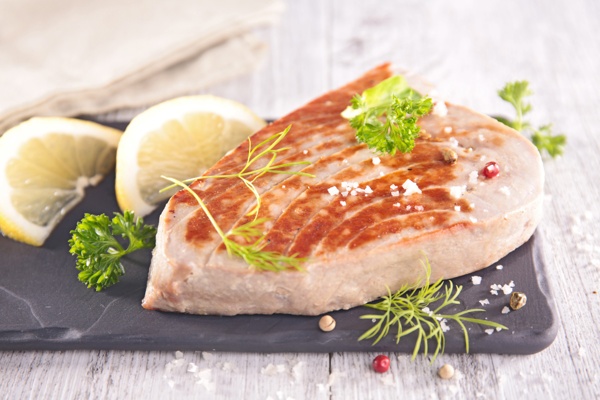Red Tuna: Nutrition and Health Benefits

Index
Red Tuna: Nutrition and Health Benefits
Bluefin t una represents one of the most sought-after varieties of tuna because of its prized meat and distinctive flavor. It is caught in the waters of the Atlantic Ocean and the Mediterranean Sea, and is one of the largest, fastest and most spectacular fish species. Bluefin tuna is welcomed in kitchens around the world not only for its culinary qualities but also for its high nutritional content. For this reason, its demand is constantly growing in global markets; therefore, it is crucial to pay attention to sustainable fishing methods to preserve the marine ecosystem for future generations. One of the most serious threats to the conservation of our seas and all the species that inhabit them is precisely intensive fishing. In addition to the latter and other harmful procurement practices such as illegal fishing, a huge problem is habitat destruction and the incidental capture of endangered species.
Therefore, buying a jar of bluefin tuna from certified sources, i.e., that follow the rules of sustainable fishing, contributes both to the preservation of the marine environment and to the quality of the product. When we buy tuna, canned or glass, as with any product, the label should be read carefully, checking that the oil used for its preservation is extra virgin olive oil. The latter not only enhances the natural flavor of the tuna steak but also increases its nutritional values.
Reason being, bluefin tuna is an ingredient of great value from both a culinary and nutritional point of view. Nevertheless, responsibility to the environment must always guide our purchasing choices, to find the right balance between taste and sustainability.
Nutritional characteristics
With a view to a healthy and balanced diet, the Mediterranean diet recommends consumption of two servings of fish per week, varying between fatty fish(e.g., tuna, carp, salmon, sardines, mackerel, anchovies) and lean fish(cod, sea bream, sole, sea bass, trout).
Bluefin tuna is a species rich in essential nutrients: it has a high content of quality protein and is an excellent source of omega-3 fatty acids, which are essential for heart and brain health. It also provides vitamins and minerals such as vitamin D, niacin, and selenium, which contribute to the overall well-being of the body.
When discussing the organoleptic properties of canned tuna, it is also important to consider the preservative variants available. Tuna in evo or olive oil tuna tends to have a higher calorie content than brine tuna, but it also offers the added benefits of monounsaturated fatty acids.
Of course, it is also crucial to pay attention to how the tuna is processed and packaged. The consumer also has a responsibility toward protecting the marine environment by choosing companies that adopt fishing methods that aim to protect natural resources.

Calories of tuna in brine
Tuna “au naturel,” that is, preserved in a solution of only water and salt, is a favorite food for those trying to control calorie intake in their diets. Generally, 100 grams of pickled tuna contains 116 calories, making it a very light and versatile food. It can be paired with fresh vegetables or salads for a nutritious yet dietary meal. However, care should be taken withdaily sodium intake: to reduce salt, it is recommended to rinse tuna under running water before consumption.
In addition to being low in calories, pickled tuna is rich in protein: each 100 grams contains about 25. This makes it ideal for those on a protein diet, suitable for bothincreasing muscle mass and maintaining muscle tone. In addition, tuna is an excellent source of omega-3 fatty acids, known for their benefits on cardiovascular health.
Choosing products from sustainable fishing methods is essential to ensure consumption that respects the marine ecosystem, allowing resources to regenerate for future generations.
Methods of tuna fishing
In Italy, there is a growing awareness of the environmental impact of fishing, which is why more and more people are choosing sustainable products. The path toward greater sustainability concerns both fishing techniques, theenvironmental impact of packaging, and product traceability.
Among sustainable methods, hook-and-line fishing is one of the oldest and most widespread systems in the world. The longline is the most widely used hooked gear: composed of a series of lines, it ends with a hook on one end and a line several kilometers long on the other. This method makes it possible to catch only large fish, such as tuna.
Another practice generally considered sustainable is purse seine fishing, which allows schools of fish to be caught without damaging the seabed. However, it must be used judiciously to avoid altering the ecosystem.
In recent years, increasingly innovative techniques aimed at reducing environmental impact are being experimented with. One of these is pole-and-line tuna fishing, which is considered among the least invasive because it allows only one fish to be caught at a time. This method, although slower and more labor intensive, represents an important source of income for local fishermen.
The fishing industry is also exploring solutions such astuna aquaculture, which could reduce pressure on wild stocks. However, this practice still presents many challenges related tofish feeding and associated environmental impacts.
Carefully reading the labels on products is key to choosing tuna from companies that comply with responsible management policies. Seeking certifications such as the Marine Stewardship Council (MSC) helps ensure informed and sustainable consumption.
-
Olive Oil Specific Weight, What It Is and How It Is Calculated
Reading time: 5 minutes Specific gravity is a value that can be calculated for all materials, both solid and liquid. However, this measurement is, for some elements, more or less important. In our case, it is very important to know the specific gravity of olive oil. We will see below why. Here we want to…
-
Olio EVO Price, Here’s the Cost of Italian EVO Oil.
Extra virgin olive oil is one of the most popular ingredients in Italian cuisine and a symbol of quality and Mediterranean tradition. But what is the price of EV O oil today? And why are there such marked price differences between one product and another? In this article you’ll find out everything you need to…

Alfio Lo Conte
Tecnico ed esperto degli oli extravergini di oliva, iscritto nell’Elenco Nazionale sezione Campania.
Maestro di frantoio con diploma, conseguito presso International Extravirgin Agency.
Read more articles by: Alfio Lo Conte
Recent Comments